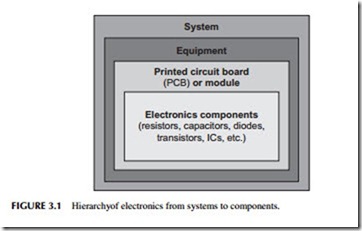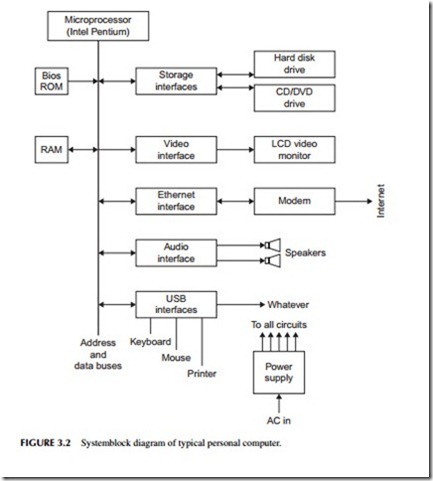WHY SYSTEMS AND NOT CIRCUITS?
What is the advantage of this approach? First, thanks to modern semiconductor technology, most electronic components and circuits are inside chips or integrated circuits (ICs). You can’t see them, and you can’t access, test, or replace them. About all you can do is learn what they do, and then work with the various input and output signals. Since you do not have access to the components and circuits, there is some argument as to why you need to learn all that circuit theory detail. If you are an engineer designing ICs, you definitely need to know this. Otherwise, it is just a waste of time unless you want to know just for the heck of it. Some of it is nice to know, of course, but in most cases it is not necessary. What you really need to know is what the circuit is, what it does, what its characteristics are, and what the inputs and outputs should look like.
A good example is the power supply in a PC. If it goes bad, you just replace it with a $30 unit that you can buy online. Troubleshooting the power supply would take many hours and require some expensive test equipment and access to spare parts. The whole repair could take hours and at a typical rate of, say, $50/hour, or more, it could cost hundreds of dollars and take weeks to get the new parts. A quick replacement with the $30 unit takes only about a half hour at most. So for less time and money, you get your PC working faster. Not a bad deal at all.
A cell phone is the same. It takes hours of troubleshooting and very expensive test equipment to troubleshoot and repair one. A typical repair would cost hundreds of dollars. Consequently, it is rarely done. It is cheaper to get a new cell phone, and it will be a better one at that. And it may even be free if you renew your service contract. That’s electronics today.
The ability to analyze circuit operation by tracing electron flow through the various components used to be necessary. That made it necessary to know about all the components in detail and how they all come together to make a circuit. But with the systems view, you rarely need this knowledge unless you are an engineer designing the circuits or the equipment. In most cases you are not, so why invest the time?
The systems view is a better approach, as you do learn about the circuits and the equipment at a higher level. Later, if you want or need to, you can delve deeper into the circuit and component details, just for fun or to satisfy your curiosity. We won’t do that in this book. But you will get the system view and big picture that will serve you well in learning electronics.
The systems view is more important today because ICs have made it possible to largely ignore the internal details. The ICs and systems on a chip (SoC) have resulted in the throw-away electronics society in which we live. It is no longer possible or economical to repair most electronic equipment thanks to ICs. The cost of labor, the cost of test instruments to troubleshoot equipment, and the difficulty of replacing ICs has made it more practical to just discard a bad piece of electronic equipment rather than repair it. It costs less and you get a newer and better replacement product as a result. Not a bad deal.
Yes, it is still possible to repair some equipment. For example, big expensive equipment such as a magnetic resonance imaging (MRI) machine is usually repairable, but it is done by replacing not bad components, but by replacing defective modules, subassemblies, or printed circuit boards.
You don’t have to know how to analyze circuits to do that. You just trouble- shoot by observing signal flow, measuring inputs and outputs, and replacing any module or subassembly that does not work. You get the equipment work- ing sooner and at lower cost.
A good way to picture the systems view is shown in Figure 3.1. It all begins with the components that make up the circuits that in turn make up the modules and subassemblies, usually on printed circuit boards (PCBs). Those are put together to form pieces of equipment. Finally, multiple pieces of equipment may end up being interconnected to form some kind of system. A few system examples will show you the idea.
A personal computer (PC) is a great example of a system (see Figure 3.2). It is made up of modules including a mother board with its processor, memory ICs, and input/output (I/O) interfaces. There is a power supply module, a hard disk drive, a CD/DVD drive, and perhaps a video card. Then the system is completed when it is connected to the video monitor, keyboard, printer, and Internet modem.
A consumer home entertainment system is made up of a big screen HDTV set, a cable or satellite box, a DVD/Blu-ray player, and an audio amplifier/ receiver with speakers. Other equipment may be involved. The TV itself or any of the other components are systems in their own right.
An iPod or MP3 player is a simple system. Shown in Figure 3.3, it consists of a memory, either a tiny hard disk drive or a solid-state flash memory that stores the music, an audio codec IC that does the digital music decompression, digital-to-analog conversion and analog-to-digital conversion for storing music, a microcontroller that controls the whole thing including the selection controls, and the LCD readout. A pair of audio amplifiers and a headset com- plete the system. A power management system charges the battery and doles out DC to power the various ICs.
An MRI machine is a whole system. It is made up of the central bed surrounded by a superconducting magnet and radio frequency–sensing coils, high-power radio frequency (RF) amplifiers and detectors, the video imaging section, and a computer that runs the whole thing.
Anyway, you get the picture. There are big systems, little systems, and lots of in-between systems. Their main characteristic today is that you cannot get at the individual components and circuits, but there are exceptions.
In this book we look mainly at the circuits, equipment, and systems, not the components. We will give you a quickie introduction to the main components but move on to the circuits and systems.


